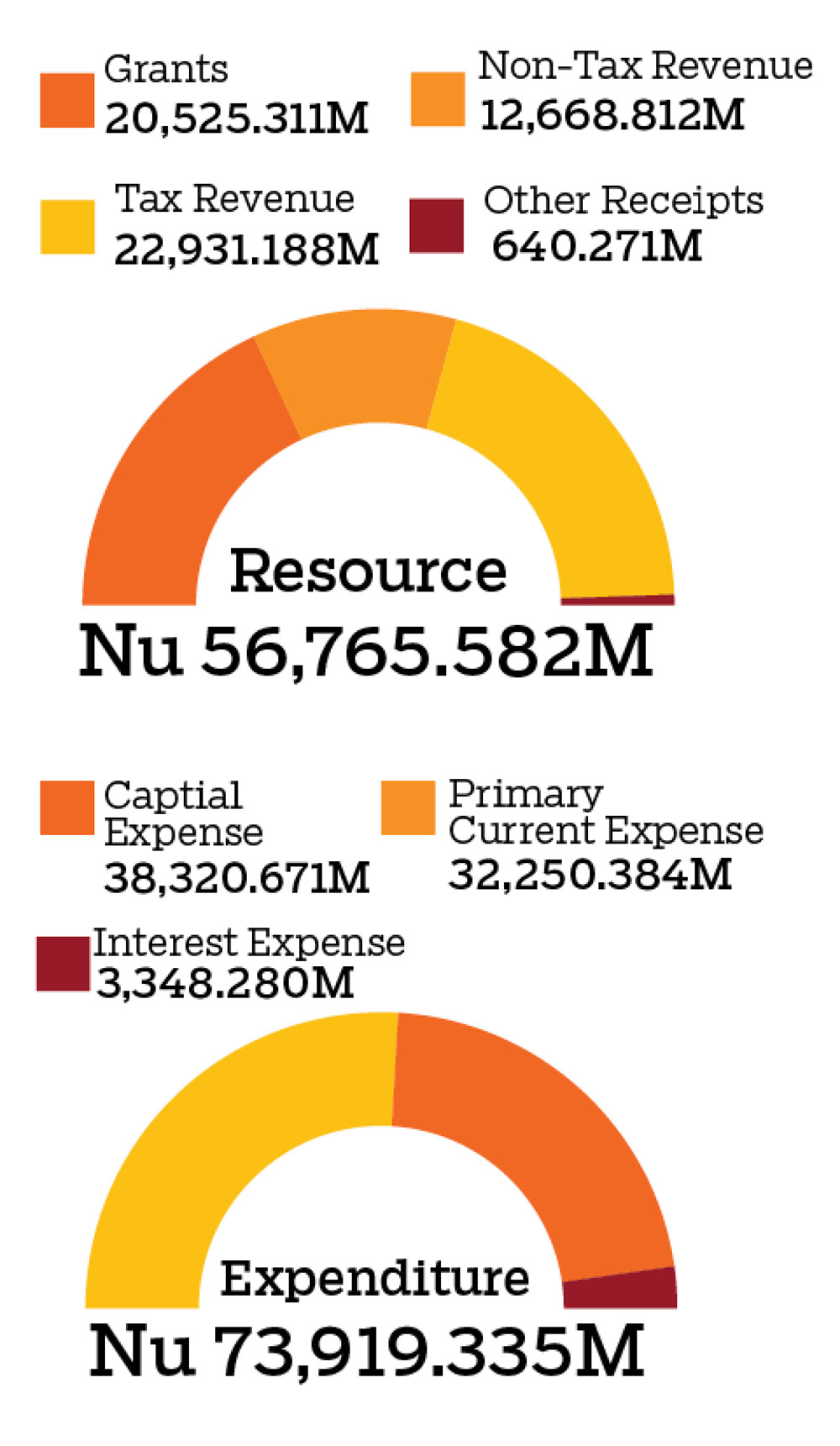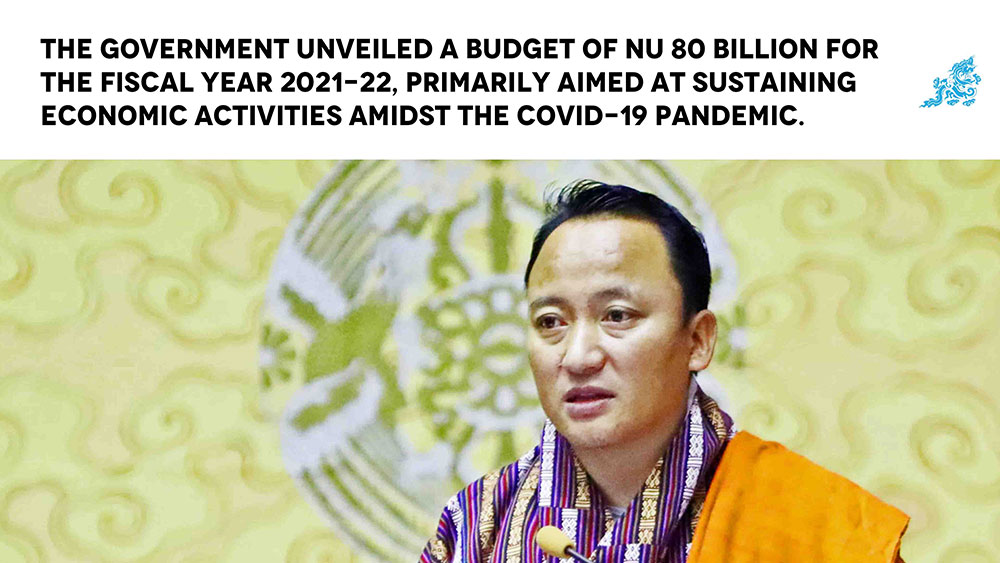GDP growth is projected at 4.1 percent
The government yesterday unveiled a budget of Nu 80 billion (B) for the fiscal year 2021-22 aimed at maintaining public confidence and sustaining economic activities amid the Covid-19 pandemic.
Of the total outlay, the proposed capital expenditure is Nu 38.32B (48 percent) and the recurrent expenditure is Nu 35.598B (44 percent). The remaining budget has been appropriated for repayment of loans.
The capital budget for the fiscal year consists 33 percent of the total 12th Plan capital outlay, which is one of the highest during the Plan period.

The practice of the capital budget ceiling at the agency level has been discontinued to ensure that budgetary bodies receive adequate capital budget for priority activities to support resilient economic recovery.
Presenting the budget, Finance Minister Namgay Tshering said that as the pandemic continued to pose serious risks to health and the livelihoods of people, the government provided necessary budget for ensuring public health and safety, maintaining public confidence and macro-economic stability.
Accordingly, the government has earmarked a budget of Nu 3B for Covid-19 related activities, including maintenance of quarantine facilities, purchase of test kits, and vaccines.
The practice of capital budget ceiling at the agency level has been discontinued to ensure that budgetary bodies receive adequate capital budget for priority activities to support resilient economic recovery.
Fiscal deficit which signifies the gap between the government’s revenue and expenditure is estimated to widen to Nu 17.153, which is 8.59 percent of the Gross Domestic Product (GDP). The government’s expansionary fiscal measure is aimed at helping economic recovery besides responding to containment measures.
“As a prudent financing strategy and to ensure debt sustainability, the government shall resort to borrowings at lowest possible costs only after exhausting the possibilities of obtaining the required financing in the form of grants,” Lyonpo Namgay Tshering said.
The government has estimated its total resources for the fiscal year at Nu 56.765B. This includes the domestic revenue of more than Nu 35.6B, other receipts of Nu 640.27M and external grants of Nu 20.525B.
The domestic revenue is expected to grow by 7 percent during the fiscal year mainly on account of estimated growth from income taxes, followed by increased consumption taxes.
The economic growth for the fiscal year 2021-22 is projected at 4.1 percent.
Lyonpo Namgay Tshering said that the Druk Gyalpo’s Relief Kidu in the form of income and interest payment support to affected individuals, along with fiscal and monetary measures, effectively mitigated the adverse impact to a large extent.
Major activities
The social service (health and education) sector has been allocated with the highest budget allocation of Nu 24.524B, constituting 30 percent of the total allocation followed by 27 percent each for economic and public services sector (agriculture, communications, housing, energy, mining, manufacturing and roads) and 24 percent for general public services.
The government has allocated Nu 140.5M for Food Corporation of Bhutan Limited (FCBL) to construct warehouse in two locations and cold storage in Phuentsholing to reduce import of potatoes during the lean seasons.
For supporting commercial organic farming, Farm Machinery Corporation Limited (FMCL) will invest in technology for producing affordable organic bio-fertilizer in a large scale, for which budget of Nu 22.1M has been provisioned.
The government has set aside more than Nu 5.835B for the road sector.
The major activities include construction of Phuentsholing-Chamkuna road, Dalbari–Dagapela secondary national highway, approach road at the National Service Center (NSC) at Taraythang, Sarpang.
The LGs will receive 34 percent of the total capital budget. The budget allocation for local governments (LGs) is almost Nu 26.032B, of which Nu 12.795B is for recurrent and Nu 13.235B million is for the capital expenditure.
However, including the centrally executed activities in various dzongkhags, thromdes and gewogs amounting to Nu 6.61B, the actual capital budget share of LGs is estimated at 52 percent of the total capital allocation.
The finance minister said that the LGs would continue to receive the budget in the form of annual grants from the government. With respect to the external funded activities, budget is provided as project-tied.
The budget also aims to transform health and education system.
The major activities under the health sector include development of health infrastructures such as ancillary works at Gidakom costing Nu 114.815M, an additional hospital wing at Jigme Dorji Wangchuck National Referral Hospital (JDWNRH) costing Nu 123.983M and a dedicated water supply for JDWNRH at the cost of Nu 16.98M.
Besides the flagship programs other regular are school infrastructure developments, the government has provisioned budget to provide scholarships to Class XI and XII students in private schools, undergraduate scholarships, and capacity development for the universities.
To stimulate economic activities and encourage private sector participation, the government will continue investing in construction, maintenance and blacktopping of roads, according to the budget.
The government will construct 36 chiwog roads, 27 farm roads, blacktop 22 gewog centre roads, and continue to improve existing farm roads (GSB and drainage).
The government will invest Nu 515M for construction and maintenance of irrigation channels.
By MB Subba
Edited by Jigme Wangchuk


